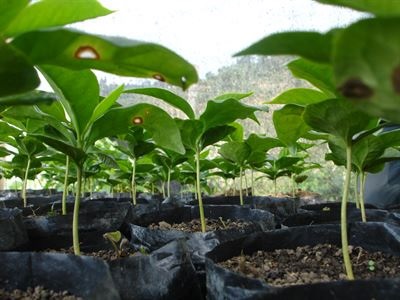Plant establishment
Definitions
To define a plant establishment, it must first be known what it is to establish something. Establish can be defined as "to start something that will last for a long time, or to create or set something in a particular way". [1] Based on that, a plant establishment can be defined as, "the act of a plant taking root within a soil where it can flourish".

Plant Establishment
When plants first colonize an area, they are limited by a number of factors including competition for resources, environmental conditions, seed availability or a lack of facilitating species. This phase is arguably the most critical part of ecosystem development. A seed has to be dispersed to an area and land on a suitable microsite while also being at a time with favorable conditions for germination and early growth. This is remedied as time goes on because succession will continue, making the abiotic factors and species interactions, like competition, more favorable for colonizing plants. The more plants that become established in an area, the higher the quality of the soil becomes. This leads to an overall higher success rate of plant establishment. When the soil quality raises to a certain point, smaller seeds are able to establish themselves, adding competition to the area, which makes the site even more suitable for other types of plants. The diversity will create many more microsites in which plants with contrasting resource requirements can establish themselves and coexist. [2] This increase in biodiversity is beneficial to the overall health of the ecosystem, and the area in general.
Physically harsh environments such as outwash plains, pumice deposits and other fresh volcanic surfaces, can be extremely limiting for plant establishment, but not impossible. In these types of areas, the soils are typically extremely infertile with very poor water holding capacity, the surface is potentially unstable, and is often exposed to wind or lacking in shelter. Any little advantage that a seed can get to survive will give it the chance to establish itself. These advantages include depressions and other concave surfaces, larger stones, rocks and already established plants. The depressions and concave surfaces may increase soil moisture, provide shelter from temperature extremes and winds, or trap seeds. The larger stones, rocks, and established plants can also create favorable conditions by reducing wind and direct solar exposure, thus lowering evaporation rates and moisture loss. [4] These species can be considered pioneer species within their environment.
Moss

Moss is a type of vegetation that is usually one of the first organisms to colonize an area, although it is typically restricted to moist environments. Mosses are considered bryophytes which are more complex than algae, yet less complex than vascular plants. [8] They have been found to be both a facilitator and a deterrent for plant establishment. Moss could potentially create shade, which can deter plants from growing due to a lack of sunlight getting to the new plants. However, the shading can also help newly establishing plants, as stated above, by limiting direct sunlight which would reduce evaporation rates. The potential increase in moisture would most likely be used by the moss itself, but most mosses are capable of surviving prolonged periods of desiccation, so plants do have a chance to receive that extra moisture, which can be seen as facilitation by the moss. [5&8] In colder environments such as an outwash plain, moss has been seen to create enough cover to protect seeds from heavy frosts, facilitating plant establishment. Mosses have also been found to secrete substances which can prove to be a deterrent for plant germination, a process known as allelopathy; however, the substances mainly affect herbivores, causing them to stay away from newly established plants. [5&6] Overall, moss can be helpful in the creation of plant establishments by buffering environmental extremes, but are not beneficial to plants once they have taken root. [6]
References
[1] "establish". Dictionary.com Unabridged. Random House, Inc. 2 May. 2018. <Dictionary.com http://www.dictionary.com/browse/establish>.
[2] Marteinsdottir, Bryndis, et al. "Multiple mechanisms of early plant community assembly with stochasticity driving the process." Ecology, vol. 99, no. 1, 2018, p. 91+. General OneFile, http://link.galegroup.com/apps/doc/A532385328/GPS?u=avlr&sid=GPS&xid=5153d942. Accessed 2 May 2018.
[3] “Plants, Types, Growing Areas.” Plants, Types, Growing Areas - The Coffee Plant - Coffea Arabica - Coffea Caneph / Dethlefsen & Balk - Tea, Coffee, Confiserie, Accessories, www.dethlefsen-balk.de/ENU/10889/Coffee_Plant.html.
[4] Marteinsdottir, Bryndis, et al. "An experimental test of the relationship between small scale topography and seedling establishment in primary succession." Plant Ecology, vol. 214, no. 8, 2013, p. 1007+. Gardening,Landscape and Horticulture Collection, http://link.galegroup.com/apps/doc/A344602188/GPS?u=avlr&sid=GPS&xid=d12f9d06. Accessed 3 May 2018.
[5] Jeschke, Michael, and Kathrin Kiehl. "Effects of a dense moss layer on germination and establishment of vascular plants in newly created calcareous grasslands." Flora, vol. 203, no. 7, 2008, p. 557+. Gardening,Landscape and Horticulture Collection, http://link.galegroup.com/apps/doc/A191002267/GPS?u=avlr&sid=GPS&xid=79640672. Accessed 4 May 2018.
[6] Drake, Paige, et al. "Mosses inhibit germination of vascular plants on an extensive green roof." Ecological Engineering, vol. 117, 2018, p. 111. Gardening,Landscape and Horticulture Collection, http://link.galegroup.com/apps/doc/A536492308/GPS?u=avlr&sid=GPS&xid=6c41986f. Accessed 5 May 2018.
[7] Britannica, The Editors of Encyclopaedia. “Moss.” Encyclopædia Britannica, Encyclopædia Britannica, Inc., 20 Sept. 2017, www.britannica.com/plant/moss-plant.
[8] Ensminger, Peter A. "Moss." The Gale Encyclopedia of Science, edited by K. Lee Lerner and Brenda Wilmoth Lerner, 5th ed., Gale, 2014. Student Resources In Context, http://link.galegroup.com/apps/doc/CV2644031481/SUIC?u=sunybuff_main&sid=SUIC&xid=971d03d3. Accessed 8 May 2018.